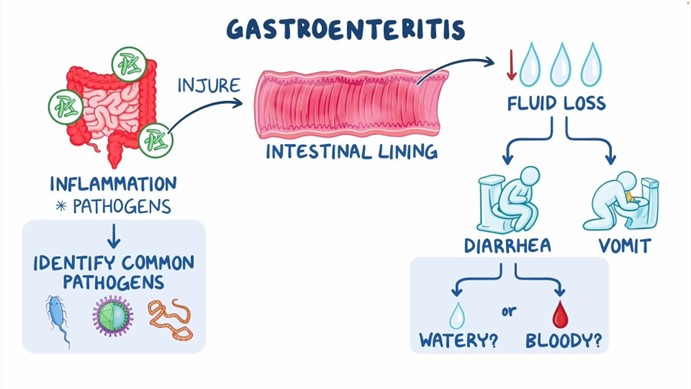A nurse is caring for a 6-week-old infant who has pyloric stenosis. Which of the following clinical manifestations should the nurse expect?
Distended neck veins
Rigid abdomen
Projectile vomiting
Red currant jelly stools
The Correct Answer is C
Choice A: Distended neck veins are not a clinical manifestation of pyloric stenosis, which is a condition that causes the narrowing of the pylorus, which is the opening between the stomach and the small intestine. Distended neck veins are a sign of increased venous pressure, which can occur in conditions that affect the right side of the heart or cause fluid overload.
Choice B: Rigid abdomen is not a clinical manifestation of pyloric stenosis, but rather a sign of peritonitis, which is inflammation of the peritoneum, which is the membrane that lines the abdominal cavity. Peritonitis can be caused by infection, perforation, or trauma to any abdominal organ. A rigid abdomen indicates severe pain and inflammation in the abdominal cavity.
Choice C: Projectile vomiting is a clinical manifestation of pyloric stenosis, as it indicates forceful expulsion of stomach contents due to obstruction at the pylorus. Projectile vomiting can occur shortly after feeding and may contain undigested milk or formula. Projectile vomiting can cause dehydration, electrolyte imbalance, or weight loss.
Choice D: Red currant jelly stools are not a clinical manifestation of pyloric stenosis, but rather a sign of intussusception, which is a condition that causes telescoping of one segment of bowel into another. Intussusception can cause obstruction and ischemia of the bowel and lead to bleeding and necrosis. Red currant jelly stools indicate blood and mucus in the stool.

Nursing Test Bank
Naxlex Comprehensive Predictor Exams
Related Questions
Correct Answer is C
Explanation
Choice A: Distended neck veins are not a clinical manifestation of pyloric stenosis, which is a condition that causes the narrowing of the pylorus, which is the opening between the stomach and the small intestine. Distended neck veins are a sign of increased venous pressure, which can occur in conditions that affect the right side of the heart or cause fluid overload.
Choice B: Rigid abdomen is not a clinical manifestation of pyloric stenosis, but rather a sign of peritonitis, which is inflammation of the peritoneum, which is the membrane that lines the abdominal cavity. Peritonitis can be caused by infection, perforation, or trauma to any abdominal organ. A rigid abdomen indicates severe pain and inflammation in the abdominal cavity.
Choice C: Projectile vomiting is a clinical manifestation of pyloric stenosis, as it indicates forceful expulsion of stomach contents due to obstruction at the pylorus. Projectile vomiting can occur shortly after feeding and may contain undigested milk or formula. Projectile vomiting can cause dehydration, electrolyte imbalance, or weight loss.
Choice D: Red currant jelly stools are not a clinical manifestation of pyloric stenosis, but rather a sign of intussusception, which is a condition that causes telescoping of one segment of bowel into another. Intussusception can cause obstruction and ischemia of the bowel and lead to bleeding and necrosis. Red currant jelly stools indicate blood and mucus in the stool.

Correct Answer is A
Explanation
Choice A: A 13% weight loss is a sign of severe dehydration in an infant, as it indicates a significant loss of body fluids and electrolytes. Dehydration can occur in an infant who has acute gastroenteritis, which is a condition that causes inflammation of the stomach and intestines, leading to vomiting and diarrhea. A 13% weight loss can also cause other signs of dehydration, such as sunken eyes, dry mouth, decreased urine output, and lethargy.
Choice B: A bulging anterior fontanel is not a sign of dehydration in an infant, but rather a sign of increased intracranial pressure, which can be caused by various conditions, such as meningitis, encephalitis, or head trauma. A bulging anterior fontanel can also cause other signs of increased intracranial pressure, such as irritability, headache, vomiting, or seizures.
Choice C: A capillary refill of 3 seconds is not a sign of dehydration in an infant, but rather a sign of normal perfusion and circulation. Capillary refill is the time it takes for the color to return to the nail bed after applying pressure. A normal capillary refill is less than 2 seconds. A prolonged capillary refill of more than 2 seconds can indicate poor perfusion and circulation, which can be caused by various conditions, such as shock, hypothermia, or heart failure.
Choice D: Bradypnea is not a sign of dehydration in an infant, but rather a sign of decreased respiratory rate, which can be caused by various conditions, such as hypoxia, narcotic overdose, or brain injury. Bradypnea can also cause other signs of respiratory distress, such as cyanosis, confusion, or loss of consciousness.

Whether you are a student looking to ace your exams or a practicing nurse seeking to enhance your expertise , our nursing education contents will empower you with the confidence and competence to make a difference in the lives of patients and become a respected leader in the healthcare field.
Visit Naxlex, invest in your future and unlock endless possibilities with our unparalleled nursing education contents today
Report Wrong Answer on the Current Question
Do you disagree with the answer? If yes, what is your expected answer? Explain.
Kindly be descriptive with the issue you are facing.
